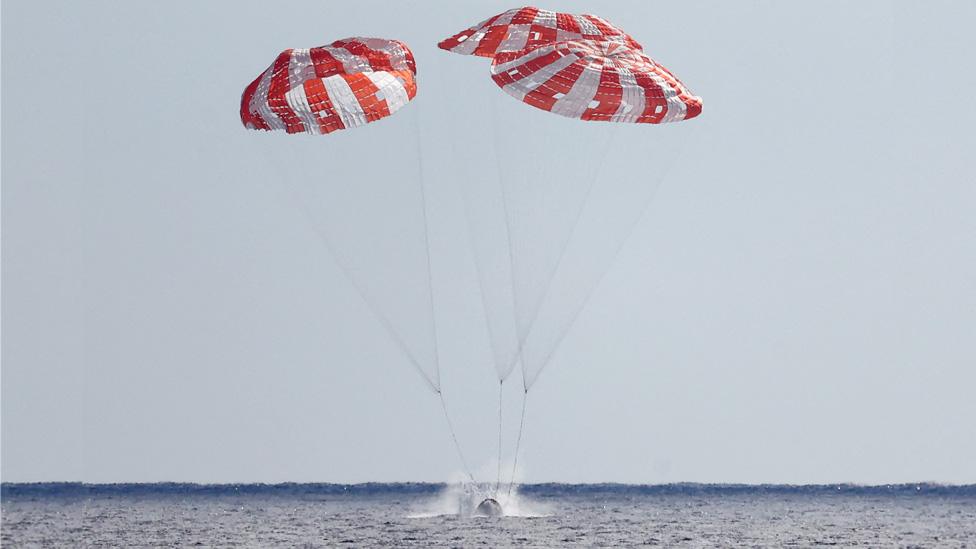Artemis I: Orion spacecraft has landed back on Earth
- Published
- comments

Nasa's Orion capsule splashed down in the Pacific Ocean off the coast of Mexico on December 11
Splashdown! Nasa's Orion capsule has landed back on Earth after its mission to the Moon.
After a fiery re-entry into Earth's atmosphere, it splashed into the Pacific Ocean after nearly 26 days in space.
This launch - called Artemis I - is part of the US space agency's wider project returning humans to the Moon, and maybe also Mars.
The Orion capsule was collected from the sea and will now be checked over by engineers to see whether it will be safe to send humans in the next mission
Orion set off from Florida on 16 November, and was put into an extended loop around the Moon on 22 November shortly after arriving.
The capsule travelled really fast when it first came into contact with the atmosphere - at around 40,000km/h (25,000mph).
As well as being super-speedy, the temperatures around the capsule get very high, so it needed to have a good heatshield to stop it from ripping apart as it comes in to land.
Engineers at Nasa will now check the ship to see whether the heatshield worked and would be suitable to protect humans in future missions to space.
Nasa put up a drone to watch Orion drop down into the Pacific Ocean
Vanessa Wyche, director of Nasa's Johnson Space Center said: "This mission is a great success for us."
"Right now, this tells us that this spacecraft has the outer bones and everything that it needs. We are going to go and finish outfitting it so that we can put humans on board for Artemis II." She added.
The Orion capsule spent nearly 26 days on its mission in space
After a few false starts with the Artemis mission, the Orion capsule spent a week looping around the Moon in a wide, sweeping orbit - travelling around the side of the lunar surface that we never see from Earth, due to its rotation.
As it passed back into view of Earth, it beamed back some amazing never-before-seen images showing the unusual angle of a close-up moon and a crescent Earth.
WATCH AGAIN: Nasa's Artemis I rocket blasts off
The test flight saw the capsule travel 270,000 miles beyond the Earth - the furthest any spacecraft designed to carry humans has ever been.
There weren't any humans on board this flight, but there were three dummies aboard which were wired with vibration sensors and radiation monitors to see how humans would've been able to survive.
If the mission has gone to plan, astronauts will be inside the capsule for another Artemis Moon mission in two years' time.
- Published20 November 2022
- Published11 December 2022
- Published6 December 2022
